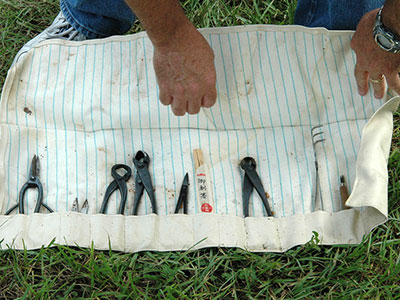Disinfecting Your Garden Tools

Disinfecting and sterilizing your horticultural tools is a good way to prevent the spread of disease-causing pathogens in your landscape. There are a number of products that can be used to disinfect tools and gardening surfaces, and each has advantages and disadvantages.
Cleaning and disinfecting are two distinct steps. Cleaning involves physically removing soil and debris and is the first step prior to disinfecting your tools. Soil and other organic residues reduce the effectiveness of disinfectants. Before disinfecting, always remove dirt, debris, or sap by wiping your tools with a damp cloth or paper towel.
Household Disinfectants
The advantages to using household disinfectants, such as Lysol, to clean are that they’re easy to find and most aren’t corrosive. The disadvantage is that little research has been done regarding their effectiveness against plant pathogens. Additionally, household disinfectants are relatively expensive when compared to other disinfectants that can be used on horticultural tools. How you use household disinfectants will vary depending on what product you are using. Generally you will want to apply a full strength spray or dip; always be sure to read the label first. Commercial household disinfectants are widely available at a variety of stores.
Chlorine Bleach
Chlorine bleach is inexpensive, effective and easy to find. However, it is corrosive, can produce harmful fumes, and isn’t as effective against viruses as some other products. To use chlorine bleach to disinfect horticultural tools, mix up a 10% bleach solution (one part bleach to nine parts water) and do a 30-minute soak. The solution has a short lifespan — effectiveness is cut in half after two hours — so fresh batches should be made for each round of cleaning. Rinse tools with clean water after soaking to prevent corrosion.
Ethanol or Isopropyl Alcohol
The advantages of alcohol (ethanol or isopropyl) to sanitize your gardening tools is that it can be used as a wipe (no soaking necessary), you don’t have to rinse the product off, and it’s immediately effective. The disadvantage of alcohols? They’re very flammable. To disinfect your tools with alcohol you can either wipe or dip them in a solution that is 70–100% alcohol. Ethanol and isopropyl alcohol are widely available at a variety of stores.
Trisodium Phosphates (TSPs)
Trisodium phosphates (TSPs) are inexpensive; the disadvantage is that they are very corrosive. To sanitize with TSP, mix a 10% solution (one part TSP to nine parts water) and let the tools sit in the solution for at least three minutes. When using TSP take care to avoid contact with your skin; the granules can cause nasty chemical burns if they stick to your skin and become wet. Many commercial TSP products are available at hardware stores and home-improvement centers. You may find TSPs in areas with painting products, as it’s commonly used to clean surfaces prior to painting. Pay attention to the label; there are synthetic versions of TSP that are useless for tool disinfecting.
Pine Oil Products
Pine oil products are not as corrosive as some other disinfecting products on the market, but they’re also not as effective. To use pine oil products, mix a 25% solution (one part pine oil to three parts water) and then soak the tools in the solution. Many commercial products are available at grocery and hardware stores and at home-improvement centers.
Industrial Products
There are several different types of disinfectants use in commercial agriculture, typically available only through horticulture-supply vendors. There are quaternary ammonium compounds, commonly called “quats” or “q-salts”, used to control fungal, bacterial, and viral plant pathogens. Products include Green-Shield® and KleenGrow™. There are also hydrogen dioxides, which are labeled as a disinfectant for use on greenhouse surfaces, equipment, tools, and for use on plants. Products included ZeroTol® 2.0 and Oxidate® 2.0.
Keep It Clean
Regardless of which product you choose, being diligent about keeping your tools clean is very important to keeping your plants healthy. A longer soaking may be needed for pruning surfaces that are not smooth. Ideally tools should be disinfected after working on every plant; however, this is usually not practical. If possible, rotate between several tools while working in the garden. That way, one tool can be disinfected while you work with another. After dipping your pruning tools, be sure to wipe away excess disinfectant to avoid injuring the next plant.
Whether you have one tool for the whole garden or many you rotate between, it is important to sterilize as frequently as possibly. Remember, clean garden tools are an important part of garden sanitation, and can prevent the spread of disease-causing pathogens. For more information on sterilizing your garden tools or dealing with disease in your landscape, contact your county Extension office.
